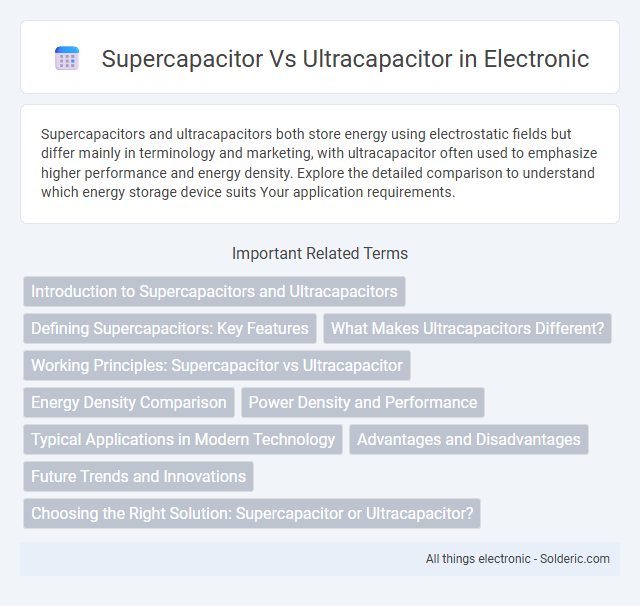Supercapacitors and ultracapacitors both store energy using electrostatic fields but differ mainly in terminology and marketing, with ultracapacitor often used to emphasize higher performance and energy density. Explore the detailed comparison to understand which energy storage device suits Your application requirements.
Comparison Table
| Feature | Supercapacitor | Ultracapacitor |
|---|---|---|
| Definition | High-capacity capacitor with high power density and rapid charge/discharge cycles. | Synonym for supercapacitor; both terms used interchangeably. |
| Energy Density | Typically 1-10 Wh/kg. | Same as supercapacitor (1-10 Wh/kg). |
| Power Density | High power density: up to 10,000 W/kg. | Equivalent power density as supercapacitor. |
| Charge/Discharge Cycles | Over 1 million cycles. | Over 1 million cycles. |
| Applications | Backup power, regenerative braking, pulse power devices. | Same applications as supercapacitors. |
| Terminology | More commonly used in industry. | Often used synonymously but sometimes implies higher performance. |
Introduction to Supercapacitors and Ultracapacitors
Supercapacitors, also known as ultracapacitors, are energy storage devices characterized by their high power density and rapid charge-discharge cycles compared to traditional batteries. Both supercapacitors and ultracapacitors utilize electrochemical double-layer capacitance and pseudocapacitance mechanisms to store energy efficiently. These devices bridge the gap between conventional capacitors and rechargeable batteries, offering advantages in applications requiring quick energy delivery and long cycle life.
Defining Supercapacitors: Key Features
Supercapacitors, also known as ultracapacitors, are energy storage devices characterized by high power density, rapid charging and discharging capabilities, and exceptional cycle life compared to conventional batteries. Their key features include a large surface area of electrode materials, such as activated carbon, and a thin electrolyte layer that enables efficient electrostatic charge storage through the electric double-layer mechanism. Understanding these properties helps you identify when supercapacitors are ideal for applications requiring quick bursts of energy and frequent charge-discharge cycles.
What Makes Ultracapacitors Different?
Ultracapacitors differ from traditional supercapacitors by their higher energy density and improved power delivery, achieved through advanced electrode materials such as activated carbon or graphene. Their unique construction enables faster charge and discharge cycles, making them ideal for applications requiring rapid energy bursts. These characteristics set ultracapacitors apart in energy storage technology, providing enhanced performance and longevity compared to standard supercapacitors.
Working Principles: Supercapacitor vs Ultracapacitor
Supercapacitors and ultracapacitors both store energy through electrostatic charge separation but differ in their working principles and construction. Supercapacitors primarily utilize electric double-layer capacitance, where energy is stored at the electrode-electrolyte interface, while ultracapacitors combine double-layer capacitance with pseudocapacitance, involving fast reversible redox reactions to enhance energy density. Understanding these distinctions can help you choose the right device for applications demanding high power delivery and rapid charge-discharge cycles.
Energy Density Comparison
Supercapacitors and ultracapacitors, though often used interchangeably, have distinct energy density characteristics influencing their applications. Ultracapacitors typically exhibit higher energy density, ranging from 5 to 10 Wh/kg, compared to supercapacitors, which generally offer around 1 to 5 Wh/kg. When choosing an energy storage solution, understanding these differences helps optimize Your system's performance where energy density is crucial.
Power Density and Performance
Supercapacitors, also known as ultracapacitors, exhibit exceptionally high power density compared to conventional batteries, enabling rapid charge and discharge cycles ideal for applications requiring bursts of energy. Ultracapacitors typically provide power densities ranging from 10,000 to 100,000 W/kg, significantly outperforming lithium-ion batteries that offer around 250-3,000 W/kg, resulting in superior performance for regenerative braking, power smoothing, and backup power systems. Their ability to deliver quick energy with minimal degradation over hundreds of thousands of cycles makes them indispensable for hybrid vehicles, grid stabilization, and portable electronic devices where consistent high power output is critical.
Typical Applications in Modern Technology
Supercapacitors and ultracapacitors are critical energy storage devices widely used in modern technology for applications requiring rapid charge and discharge cycles. Supercapacitors are commonly implemented in regenerative braking systems in electric vehicles, providing quick bursts of energy recovery to improve efficiency. Ultracapacitors excel in power backup systems, grid stabilization, and wearable electronics where high power density and long cycle life are essential.
Advantages and Disadvantages
Supercapacitors and ultracapacitors both offer rapid charge and discharge cycles, with ultracapacitors typically possessing higher energy density but at a greater cost compared to supercapacitors. Your choice depends on application needs; supercapacitors excel in longevity and lower cost, while ultracapacitors provide superior power density and faster energy delivery. However, supercapacitors face limitations in energy storage capacity, whereas ultracapacitors may experience reduced lifespan under high-stress conditions.
Future Trends and Innovations
Supercapacitors and ultracapacitors are driving advancements in energy storage with innovations in graphene-based electrodes and hybrid systems combining battery and capacitor technologies. Emerging trends include enhanced energy density, rapid charging capabilities, and improved lifespan through nanomaterial engineering and electrolyte optimization. Future applications focus on electric vehicles, grid stabilization, and wearable electronics, leveraging their high power output and efficient energy management.
Choosing the Right Solution: Supercapacitor or Ultracapacitor?
Supercapacitors and ultracapacitors, often used interchangeably, differ slightly in energy density and power capabilities, influencing their application suitability. Supercapacitors excel in rapid charge-discharge cycles with lower energy storage, ideal for regenerative braking and backup power systems, while ultracapacitors provide higher energy density, fitting applications requiring longer energy delivery. Evaluating power density, energy storage needs, and cycle life ensures selecting the optimal capacitor for specific industrial, automotive, or consumer electronics demands.
supercapacitor vs ultracapacitor Infographic

 solderic.com
solderic.com